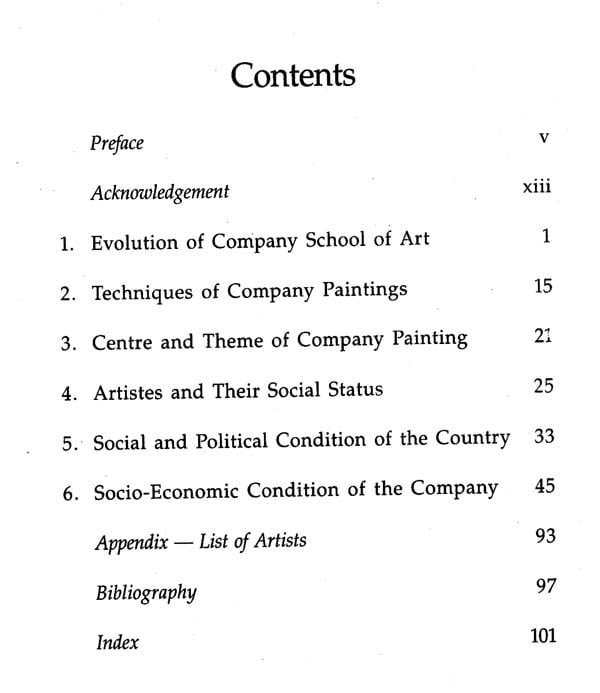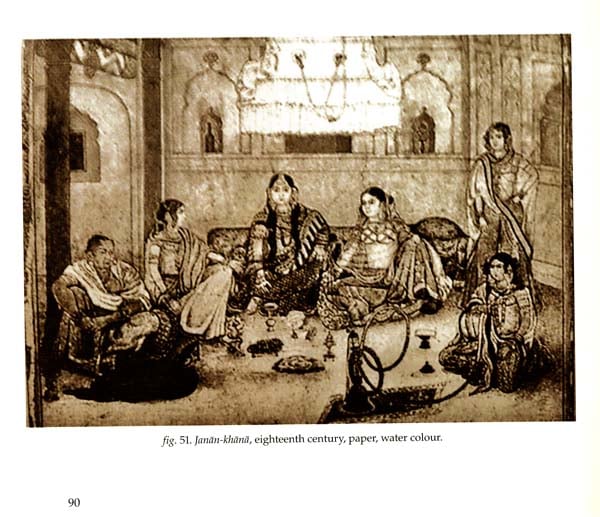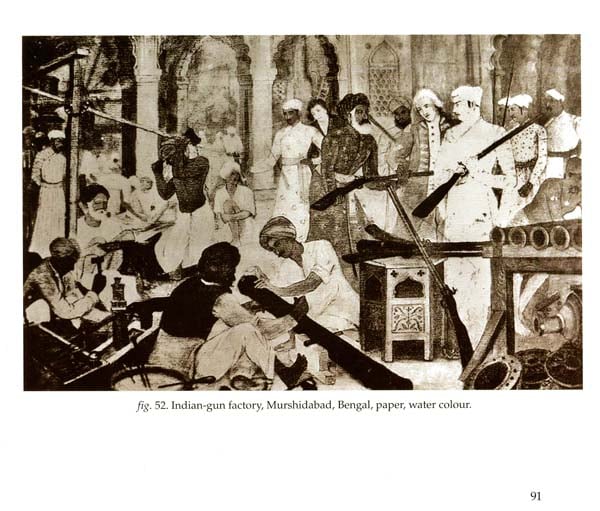
A Socio-Economic Study of Company Paintings
Book Specification
| Item Code: | NAW027 |
| Author: | T.N. Mishra |
| Publisher: | D. K. Printworld Pvt. Ltd. |
| Language: | English |
| Edition: | 2011 |
| ISBN: | 9788124605714 |
| Pages: | 104 (59 Colored Illustrations) |
| Cover: | HARDCOVER |
| Other Details | 8.00 X 9.00 inch |
| Weight | 580 gm |
Book Description
The paintings of the eighteenth and nineteenth centuries are recognized as a valuable source for the study of social and economic life during the colonial period. A deep study of the Company paintings of the time is significant because the paintings have carefully observed and recorded the Indian scene in all its aspects, particularly its history and society.
The book discusses the evolution of the Company School of Art, as a result of interactions between traditional Indian paintings and European paintings, and its spread to most of the art centres in India. Ina thorough attempt, it deals with its thematic preoccupations and the. common features of the paintings: their favourite subjects, especially their depiction of the professions, and the variety of common people they carefully depict. It examines the techniques adopted by the artists: their choice of mediums and colours and their style of depicting the themes. It also takes up the social status of the artists at the time. The book will fascinate lovers of Indian art and will prove useful to scholars and students especially involved in study of evolution of Indian art and modern art.
Dr T. N. Mishra has researched various aspects of Indian philosophy and art and architecture in a career spanning over three decades. He has published articles in reputed journals on the subject and authored works that include Buddhist Tantra and Buddhist Art; Ancient Indian Bricks and Brick Remains; Westernization of Indian Art; Impact of Tantra on Religion and Art; Yoga-Tantra and Sensuousness in Art; and Feminine Beauty in Indian Art and Literature. Retired as Curator from the prestigious Bharat Kala Bhavan, he is presently working as Senior Academic Fellow at Banaras Hindu University.
Art reflects contemporary society. This holds good also with reference to Company Paintings. Like other source materials, the art of the period possesses tremendous potentialities in reconstructing the social history of the Company Period. A careful analysis of the Company paintings done on paper, glass, ivory, mica, etc. offers a graphic description on contemporary society.
For the study of social and economical life in the eighteenth and nineteenth centuries, our dependable source has been the painting of the periods. One of the principal criteria for the identification of this class of painting is the degree to which it observed the Indian scene in all its aspects, including history and society. The company painting in its heyday, during eighteenth century carefully observed and recorded the life as such.
Art reflects contemporary society. This maxim holds good also for that group of paintings which was designated in the late eighteenth century as Company Paintings. Pictures painted on cheap paper (firkas) or machine-made Western paper, laid bare a life lived in palaces, waysides, villages and small towns. These depicted the princes and people, beggars and saints, traders and merchants, animals and birds, religious and secular architecture, means of transport, different castes and creeds, and people engaged in different professions — in fact, it revealed the graphic picture of the contemporary period.
The term "Company Paintings" has been coined by Indian art historians to denote a special group of paintings, which was evolved due to an interaction between traditional Indian paintings and European paintings of eighteenth and nineteenth centuries CE. This class of painting thus evolved and illustrated Indian socio-political life, birds, animals, personal portraits, etc. This new style of painting included European perspectives, light and shade, colour combination, and utilization of machine-made paper, etc. Certain scholars preferred to designate this new idiom as "Patna Painting" while others called it "Firangi-Kala." The name "Company School" appears to be the most appropriate one, since this style evolved during the tenure of the East India Company’s rule in India and most of the scholars in the field approved of this name. This art style developed through European contact and had spread in most of the art centres of India; each centre maintained certain distinctive features of its own and is identifiable by distinct regional flavour and provincial character too.
Before the advent of the so-called Company style, the whole of northern India witnessed a group of paintings entitled Later Mughal School in which one finds the decadence of Imperial Mughal School flavour, : skill and competence. Mughal miniatures show certain things that were never seen before in India, and their lasting effects reverberated throughout India even after the Mughals. The Mughal emperors were keen lovers of nature and art, and their personalities were, to a certain extent, reflected in art and culture of their time.
The Mughals were in contact with European traders and missionaries from the period of Akbar and, therefore, mention requires to be made here that the impact of European paintings was deeply felt in the development of the Mughal painting. By virtue of the novelty and fineness or fine technical quality of the Western art, the Mughal artists realized their own shortcomings, and introduced considerable improvement in the technique of shadowing, modelling and perspective and the inspirations came from the West. The traits which they accepted from the West were thoroughly integrated in their style in such a way that nothing remains visible other than some faint traces of technical details.
Mughal painting lost much of its glamour and refinement within a few years after Jahangir’s death. Though Shahjahan was interested in miniatures and illustrated manuscripts in his days, his enthusiasm was kept reserved for architecture. On the other hand, Aurangzeb who succeeded him was so orthodox and averse to painting that the highly developed art of miniature painting headed for steady decline. The court artists began to feel insecure in the absence of support, encouragement and patronization and were even compelled to leave Delhi in search of means of sustenance elsewhere. The painters thus chose to migrate to the court of other favourable patrons. The centres for artists were thus shifted to other regions. Consequently, one finds the evolution of so-called Later Mughal School of Painting.










